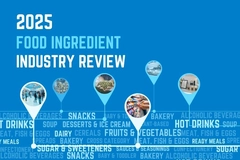
- Industry news
Industry news
- Category news
Category news
- Reports
- Key trends
- Multimedia
- Journal
- Events
- Suppliers
- Home
- Industry news
Industry news
- Category news
Category news
- Reports
- Key trends
- Multimedia
- Events
- Suppliers
Indulgent treats with 200 calories or less dominate US market as big players boost portion guidance

09 Sep 2022 --- As healthy indulgence trends continue to gain traction, a new report reveals that 85% of chocolate and candy sold today in the US comes in packaging that contains 200 calories or less per pack. The confectionery industry has been making strides in reducing sugar and overall calorie content, with big players exceeding targets.
Companies like Mars Wrigley, Ferrero, Ferrara Candy Company, Lindt, Ghirardelli Chocolate, and Russell Stover Chocolates – reportedly exceeding targets, according to National Confectionery Association and Partnership for a Healthier America (PHA) analysis.
The report comes at the end of a five-year initiative - entitled Always a Treat - between the non-profit health organization PHA and industry to improve transparency in front-of-pack labeling and reduce package sizes and therefore calories.

This was a voluntary project that required innovation and reformulation from the confectionery industry.
According to the analysis, the data demonstrates that the confectionery industry has “stepped up” on nutrition guidelines for consumers without hurting their portfolios and profits.
One of the key findings is that the confectionery sector has hit the marks on providing more transparency on labels and smaller packaging.
“Consumers want options when it comes to chocolate and candy and information on how to make informed choices about how they treat – in fact, 72% of consumers agree that it is important for chocolate and candy brands to offer portion size variety,” Carly Schildhaus, senior manager of public affairs at the National Confectioners Association, tells FoodIngredientsFirst.
“Over the last five years, the Always A Treat Initiative has transformed the retail landscape related to the confectionery category and though there are no specific plans for another commitment at this time, it’s clear that the entire industry is directionally aligned, as 85% of chocolate and candy sold today comes in packaging that contains 200 calories or less per pack, which includes individually wrapped products or multipacks that contain smaller packages inside.”
 85% of chocolate and candy sold today in the US comes in packaging that contains 200 calories or less.Key findings
85% of chocolate and candy sold today in the US comes in packaging that contains 200 calories or less.Key findings
Now, half of the individually wrapped products made by the participating companies are available in sizes containing 200 calories or less per pack. This is up from 38.3% in the 2016 benchmark year.
Also, 94.8% of confectionery products have front-of-pack calorie labels – which is up from 53.7% over the five years. This number is even higher at retail checkout, with 98% of chocolate and candy packaging found at the front of the store containing calorie labels printed on the front of the pack.
“Our industry is continuing to focus on innovation in packaging and products to meet our consumers and retail partners’ needs and desires for great-tasting treats,” adds John Downs, NFA president and CEO.
Examples of reduced weight confectionery NPD
In the UK market, in 2020 Mondelēz brought all its Cadbury chocolate bars sold as part of a multipack under 200 calories, in a voluntary portion-control strategy for consumers to tackle obesity. Targeting 100 calorie packs for its Cadbury chocolate and wider biscuit products.
In 2018, Cadbury Dairy Milk with 30% less sugar, hit the shelves as confectionery giant Cadbury ramped up its initiative to drive down sugar in its products.
Hershey is also banking on better-for-you confectionery looking to offer customers a wider-array of portion controlled offers. Mars and Snickers have also, since 2018, been extending its reformulated range to include smaller portion sizes and low-calorie versions of classic candies and chocolates.
High production costs are also, involuntarily, helping to reduce portion sizes through what has been named “shrinkflation,” where shelf stable food brands are downsizing the size or quantity of their products while keeping them at the same price.
There is pressure on brands to make great-tasting, better-for-you food and beverages with fewer or zero grams of sugar, according to Casey McCormick, VP of global innovation at Sweegen. In this week’s special report Healthy confectionery: Ramping up sugar-free concepts, free-from and environmental claims surge, FoodIngredientsFirst details the better-for-you trends in the confectionery sector.
Better-for-you on the rise
In an Innova Market Insights report about health and nutrition, 73% of consumers from an average of ten countries say that they try to limit or reduce products/ingredients that are ‘bad’ for them, such as high in sugar, salt, fat, etc.
However, this is not always easy for formulators, which have to balance taste, health and functional considerations.
“Crafting a craveable flavor with reduced levels of sugar or fat is probably the biggest challenge for formulators, but the functional considerations of healthy confectionery go way beyond taste,” addss Dr. J.I.X. Antony, VP for innovation at olam food ingredients.
“Sugar acts as both a bulking agent and natural preservative in many recipes, helping improve texture and extend shelf life. Artificial sweeteners and preservatives can be added to replicate the role of sugar, but growing consumer desire for simple, easily recognizable ingredients makes this route less viable for products with a ‘healthy’ positioning,” he continues.
According to Antony, the solution lies in the clever use of natural, nutritious ingredients to replace sugar or saturated fats in confectionery formulations.
In terms of saturated fat reduction, natural ingredients are flagged by Antony as key. Cocoa butter can be used as an alternative to the typical hydrogenated fats used in confectionery products and comes with the added advantage of being a familiar, clean-label ingredient consumers trust.94.8% of confectionery products have front-of-pack calorie labels – which is up from 53.7% over the five years.
In sugar-free formulators have to opt for high-intensity sweeteners like Stevia or monkfruit.
“Here too, cocoa powder can soften the off-tastes of these ingredients, creating a complete flavor profile rather than just sweetness overload,” explains Antony.
“Another effective way to maintain a rich mouthfeel and flavor in healthier chocolate products is by incorporating zero-fat cocoa powders or medium alkalized cocoa powders, which can reduce sugar content in a recipe by 10-20%,” he notes.
US confectionery market
North America accounts for 12% of the share of the global confectionery launches tracked by Innova Market Insight between April 2021 and March 2022. Making it the fourth leading region in NPD after Europe (46%), Asia (22%) and Latin America (14%).
However, North America is forecasted to account for 20% of all the global confectionery sales and 23% of the chocolate confectionery sales. Showing that company NPD efforts are going toward less mature markets.
Nevertheless, sales are growing steadily in the US at a CAGR of 4.1% (2020-2022) and in a slower manner in Canada with a 1.7% CAGR.
By Gaynor Selby and Marc Cervera










